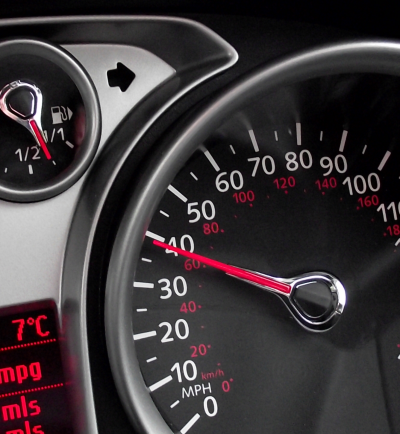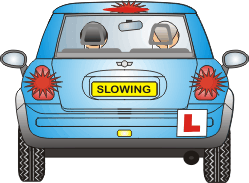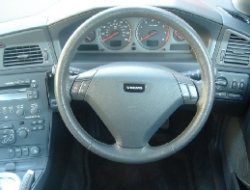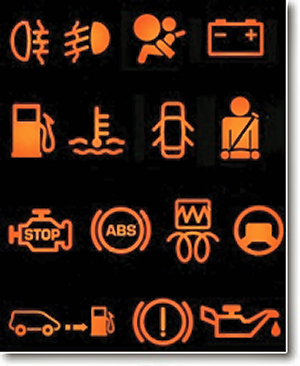The controls
 This page contains information designed to get you thinking about the controls - this information is fairly basic, but remember that if you get the foundation wrong you will build shaky driving skills!
This page contains information designed to get you thinking about the controls - this information is fairly basic, but remember that if you get the foundation wrong you will build shaky driving skills!
Another important point to bear in mind is that you will be teaching people of all experience ranges - the way that the information is explained here will help you to build your own explanations.
Accelerator (or 'gas pedal')
Many people use the accelerator harshly; this results in a 'stop-go' drive and poor fuel economy.
Skilled drivers use the accelerator smoothly and progressively and pay special attention to the accurate matching of road and engine speeds during gear changing.
Your aim here is to drive without 'accelerator surge' or jerky engine braking on downward gear changes.
An important skill for an advanced driver is 'acceleration sense'. This means using the accelerator 'just enough' to supply the road speed for any given situation without having to resort to over-use of the brakes.
Gaining good acceleration sense will lower your fuel costs, reduce wear and tear on your vehicle, reduce driving stress and give your passengers a more comfortable ride.
If you choose take additional advanced driving lessons your trainer may use the term 'gas pedal' when referring to the accelerator. This is done for ease of instruction and understanding – 'more gas', for example, would mean press the pedal a bit harder, 'less gas', a little less.
Brakes
The footbrake, like the accelerator, should be used smoothly and progressively.
When possible, braking should be achieved with the car following a straight course for maximum stability - braking when steering  left or right will unbalance the car making it more difficult to control and increasing the chances of a skid..
left or right will unbalance the car making it more difficult to control and increasing the chances of a skid..
The handbrake (parking brake) should be used when required, generally without clicking of the ratchet unless specified in your vehicle operators handbook.
Failing to press the ratchet release button when applying the handbrake can result in excessive ratchet wear, however, it is more likely to result in 'stretching' of the handbrake cables, making the handbrake less effective and increasing service costs.
'When required' means whenever the car is stopped for more than a few seconds in traffic or when waiting at junctions. The handbrake should only be used when the vehicle has come to a complete halt. Because the brake works on the back wheels only 99% of vehicles, using the brake when moving could result in a rear wheel skid (causing loss of control).
Smoooooth stops...
Stopping should be smooth and free of jerks.
A good definition of how your stops should feel comes from Roadcraft, the police driving manual, which describes the stopping action as 'a smooth gliding halt'. You should aim for this every time you stop the car.
To achieve smooth braking in all situations you will need to learn to 'read the road' (later in this guide). Your smooth use of the footbrake will then be part of the mix that will help you to improve your fuel economy. later you will learn about progressive braking and how there should be little or no pressure on the brake pedal as the car stops.
As an advanced driver, you need to be aware of how your use of the brake pedal (or non-use) gives a message to following drivers via your brake lights - are they getting the information they need when they need it? Your brake lights warn following drivers that you are slowing down every time you press the footbrake.
Sometimes it can be useful to touch the brake pedal very lightly, without slowing down, to activate the brake lights. By doing you this will give drivers who are following too closely a bit more time to react when you start to slow down. Because the brake lights are a signal, you need to find out who you are 'talking to' by looking in your mirrors before you press the brake pedal.
Clutch
 When driving a manual car, good drivers are able to operate the clutch smoothly without the car pitching forward or backwards on the suspension.
When driving a manual car, good drivers are able to operate the clutch smoothly without the car pitching forward or backwards on the suspension.
Your passengers should barely notice your gear changes (if at all!).
Later in this course, in the 'Swan Lake' project, you will learn how to balance the clutch and gas pedal to avoid 'clutch drag' when slowing down (caused by using gears to slow down rather than brakes).
Smooth driving saves fuel!
(AA figures show that eco-driving can use up to 33% less fuel.)
The ability to double-declutch is not required for advanced driving or DVSA tests these days, mainly because modern vehicle design generally makes it unnecessary however, learning the technique will improve your feel for the vehicle. An understanding of double-declutching is desirable for instructors and use of this method could be demonstrated on test if it would be beneficial to the drive in any given situation.
For those of you who are not mechanically-minded, pressing down the clutch pedal breaks the link between the engine and the driving wheels; this is what allows you to change gear and stop the car without stopping the engine.
Gears
 In order to pass any advanced driving test and to drive in an eco-friendly manner, you will need to understand the need for, and be able to demonstrate an ability to select, the correct gear at all times.
In order to pass any advanced driving test and to drive in an eco-friendly manner, you will need to understand the need for, and be able to demonstrate an ability to select, the correct gear at all times.
The gear that you choose will depend upon your road speed, the load on the engine and the prevailing traffic conditions.
The physical aspects of gear changing can also make a difference to how well you drive: your grip on the gear lever, smooth overall action, etc.
With this in mind you will need to ensure that the pedals are 'balanced' keeping your speed and/or engine revs matched for smooth changes.
Selective gear changing: To achieve smooth and efficient gear changes you will need to use selective gear changes (also known as 'block' gear changes). For example by changing from 4th to 2nd / 5th to 3rd / 1st to 3rd, etc.
Many older drivers may have been taught to change the gears sequentially – 1, 2, 3, 4, 5 then 5, 4, 3, 2, 1 – however, because of modern technology and changes in vehicle design over the years this is no longer necessary and indeed has not been necessary since the late 1960's (Despite what your old instructor might have told you!).
Cars are much lighter than they used to be and brakes are far more powerful; this means that it is now rarely necessary to use 'gear assisted braking in normal road driving.
Steering
 Everyone can steer, surely?
Everyone can steer, surely?
It's surprising how many drivers are 'harsh' in their use of the steering wheel.
This can cause instability and excessive tyre wear. Like everything else about driving there are useful and less useful ways of doing things!
According to the UK authorities (DVSA and Police) for normal road driving your use of the steering wheel should generally involve the pull/push (shuffle) method – however, times are changing and in many situations, or for many people, this is neither a comfortable or efficient way to steer.
The pull-push method can offer control in most situations. Some people, however, may not find this method suitable for slow manoeuvring. especially when this involves turning around in your seat, or for driving on fast open roads with bends and curves.
The basic rule for steering is that you must retain maximum control at all times. Common sense should enable you to decide how this control is to be achieved in a way that is comfortable for you.
Observation and steering: Your driving instructor should have stressed the importance of the link between observation and steering, however, many drivers have not grasped this, especially when driving briskly on open roads. One of the most common open road accidents - spinning or driving off on bends - could be avoided if the driver knew more about where to look!
Good steering is dependent upon good observation. By becoming aware of exactly where you are looking when steering you will start to recognise the root of most, if not all, of the steering problems - problems that you might not even know you have.
Vehicle balance should be maintained through bends and corners this will help to increase your fuel economy – appropriate observation is a key element in maintaining balance; an understanding of vehicle dynamics will also help in this respect as the weight shift of the vehicle will dramatically affect the steering characteristics when travelling at higher speeds...
Auxiliary controls
How well do you know your car?
 You should be able to operate any of the auxiliary controls as and when required when driving - good vehicle knowledge is essential for safe driving. This means that you must be fully conversant with the controls of the car that you take any advanced test in.
You should be able to operate any of the auxiliary controls as and when required when driving - good vehicle knowledge is essential for safe driving. This means that you must be fully conversant with the controls of the car that you take any advanced test in.
By learning about your vehicle you will become safer - being distracted for a second while you locate the switch you want of change the radio station on an unfamiliar entertainment system can be fatal.
In one second at just 50mph you will cover approximately 25 metres, and considering that you are often a metre or less from the kerb or from other vehicles ... Remember this next time you reach across to change a CD.
Correct use of the horn and of flashing head lamps must be fully understood. Use of the ventilation system and/or air conditioning will be important to keep windows clear on damp days.
Plus, you will need to keep and eye on your instruments - running out of fuel will not help you to get home or to pass an advanced test, neither will illuminated warning lights. If a warning light is on, a tester might refuse to conduct an advanced test - even if you know that the car is OK and the light is faulty. Do you monitor what is switched on? having things running unnecessarily will use extra fuel - simply monitoring these things will add to your economic driving.
And what do you know about ABS, ESP and other safety systems that you car might be equipped with?
Project
You can find information about your car's controls in the manufacturer's handbook.
As a brief project, spend ten minutes with your handbook and see if you can find out something that you didn't know previously.
If you find lots of things you didn't know, spend half an hour!
As a minimum you should be fully familiar with the information about switches, dials and lights described on the DriverActive site.
Next: Move on to Step 4 and watch the short video introduction about road skills.